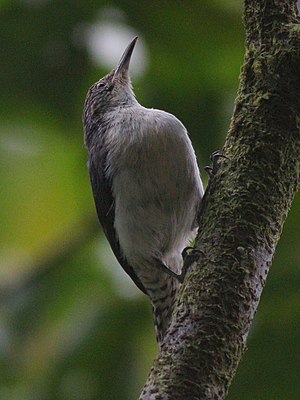Gray-coat wren
| Gray-coat wren | ||||||||||||
|---|---|---|---|---|---|---|---|---|---|---|---|---|

Gray- coat wren ( Odontorchilus branickii ) |
||||||||||||
| Systematics | ||||||||||||
|
||||||||||||
| Scientific name | ||||||||||||
| Odontorchilus branickii | ||||||||||||
| ( Taczanowski & von Berlepsch , 1885) |
The gray coat Wren ( Odontorchilus branickii ) is a bird art from the family of wrens (Troglodytidae) in Colombia , Ecuador , Peru and Bolivia is widespread. The IUCN assesses the population as Least Concern .
features
The gray-coat wren reaches a body length of about 12.0 cm with a weight of about 9.0 to 10.2 g. It has indistinct grayish to white stripes above the eyes , gray-brown ear covers with gray-white stripes. The top of the head is brown, the shoulders and the back are medium gray which turns brown at the rump . The wings of the hand , the wings of the arm are a little darker gray than the back color. The tail is medium gray with striking black bands. The outer control springs have a white subterminal band that can be seen from the underside. The underside is whitish with a slightly yellow-brown tint. The under tail-coverts have distinct black horizontal stripes. The eyes are brown, the upper beak black, the lower beak silver-gray. The legs are gray. Both sexes are similar. Young animals are a little more yellowish brown on the underside and the brown on the front upper head is duller.
Behavior and nutrition
Little data are known on the diet of the gray-coat wren. Examination of some of the bellows revealed only invertebrates in the stomach. He looks for his food in the strata of the forest canopy. He is often traveling alone or mixed regularly in other groups, for example, tanagers and Bekarden ( Pachyramphus Gould & Gray, GR , 1840).
Vocalizations
The singing of the gray-mantled wren consists of high metallic trills of a uniform pitch, which are trilled faster and more clearly than is the case with the tooth-billed wren. It is more reminiscent of the singing of North American wood warblers than of other wrens. The call consists of a high si-si-si , which is also atypical for a wren.
Reproduction
The breeding biology of the gray-coat wren has not yet been researched or there are no reliable data.
distribution and habitat
The gray-coat wren prefers moist subtropical and higher tropical forests. Here it usually occurs at altitudes between 1400 and 2200 meters, sometimes higher. On the mountain slopes near the Pacific , it occurs at altitudes of 800 to 1100 meters.
migration
The gray-coat wren is likely a resident bird .
Subspecies
There are two known subspecies:
- Odontorchilus branickii branickii ( Taczanowski & von Berlepsch , 1885) is distributed from southern Colombia through eastern Ecuador and Peru to western Bolivia.
- Odontorchilus branickii minor ( Hartert, E , 1900) occurs in the southwest of Colombia and the northwest of Ecuador. This subspecies is smaller. The stripes on the central control springs are only rudimentary.
Etymology and history of research
The first description of the gray coat Wren was made in 1885 by Władysław Taczanowski and Hans Hermann Carl Ludwig von Berlepsch under the scientific name Odontorhynchus branickii . The type specimen came from the collection of Count Konstanty Grzegorz Branicki (1824–1884) was collected by Jan Stanisław Sztolcman (1854–1928). In 1915 Charles Wallace Richmond introduced the genus Odontorchilus, which was new to science, for the tooth- billed wren ( Odontorchilus cinereus ( von Pelzeln , 1868)), since Odontorhynchus was already occupied by Odontorhynchus Leach , 1830. This name is derived from "odous, odontos οδους, οδοντος " for "tooth" and "orkhilos ορχιλος " for "wren". The species name »branickii« honored the former owner of the type specimen . "Minor" is the Latin word for "smaller".
literature
- Donald Eugene Kroodsma, David Brewer in: Josep del Hoyo , Andrew Elliott, Jordi Sargatal , David Andrew Christie , Eduardo de Juana: Gray-mantled Wren (Odontorchilus branickii) in Handbook of the Birds of the World Alive . Lynx Edicions, Barcelona.
- James A. Jobling: Helm Dictionary of Scientific Bird Names . Christopher Helm, London 2010, ISBN 978-1-4081-2501-4 .
- Hans Hermann Carl Ludwig von Berlepsch, Władysław Taczanowski: Troisième list des Oiseaux recueillis par MM. Stolzmann dans L'Ecuadeur . In: Proceedings of Scientific Meeting of the Zoological Society of London for the Year 1885 . 1885, p. 67-124 ( biodiversitylibrary.org ).
- Ernst Hartert: Mr. Ernst Hartert exhibited some new South-American birds, which he described as follows . In: Bulletin of the British Ornithologists' Club . tape 11 , no. 76 , 1900, pp. 37-40 ( biodiversitylibrary.org ).
- Charles Wallace Richmond: Notes on several preoccupied generic names (Aves) . In: Proceedings of the Biological Society of Washington . tape 28 , 1915, pp. 180 (English, biodiversitylibrary.org ).
Web links
- Odontorchilus branickii inthe IUCN Red List of Threatened Species 2019.3. Listed by: BirdLife International, 2018. Retrieved February 21, 2020.
- BirdLife International: Species Factsheet - Gray-mantled Wren ( Odontorchilus branickii ) . Retrieved February 21, 2020.
- Videos, photos and sound recordings of Gray-mantled Wren (Odontorchilus branickii) in the Internet Bird Collection
- Gray- coat wren ( Odontorchilus branickii ) at Avibase; accessed on February 21, 2020.
- Odontorchilus branickii in the Integrated Taxonomic Information System (ITIS). Retrieved February 21, 2020.
- xeno-canto: Sound recordings - Gray- coat wren ( Odontorchilus branickii )
- Gray-mantled Wren (Odontorchilus branickii) in the Encyclopedia of Life . Retrieved February 21, 2020.